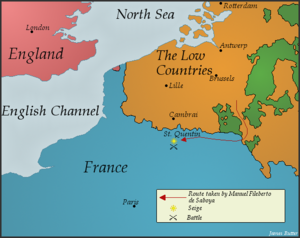Battle of Saint-Quentin (1557)
| date | August 10, 1557 Jul. |
|---|---|
| place | Saint-Quentin |
| output | Victory of Spain |
| Parties to the conflict | |
|---|---|
| Commander | |
| Troop strength | |
| 6,000 infantrymen 4,000 horsemen |
18,000 infantry, 6,500 horsemen |
| losses | |
|
approx. 200 dead and wounded |
approx. 7,000 to 8,000 dead and wounded |
The battle of Saint-Quentin took place on August 10, 1557 jul. within the Habsburg-French conflict (1552–1559) and led to a decisive victory for the Spaniards over the French . This came about because the Spanish King Philip II had secured the support of England and Queen Mary I as an ally.
prehistory
Since 1552, Emperor Charles V , who was also King Charles I of Spain, waged war against the French King Henry II. After the death of his daughter-in-law Maria of Portugal, he urged his son Philip to marry the English Queen Maria in 1554 , the half-sister of the later Elizabeth I , to bind England to Spain in an alliance. In the marriage contract between the two, however, England was assured a neutral position if one of Philip's other territories were at war.
When Charles abdicated in 1556, Philip took the throne of Spain and continued the dispute with France. For this reason he urged his wife to disregard the marriage contract and to support his army by English troops, which he was eventually granted.
The battle
The battle took place on the feast day of St. Lawrence (August 10, 1557 July ). The battlefield was outside the walls of Saint-Quentin , a town about 130 km northeast of Paris.
The Spaniards were under the command of Duke Emanuel Philibert of Savoy and were supported by an English army under the command of William Herbert , 1st Earl of Pembroke . On the other side, the French army was under the leadership of Connétable Anne de Montmorency , a French nobleman who was also King Henry's most important advisor.
The English army did not reach the battlefield in time, but played an important role in the subsequent conquest of the city.
The Spanish troops, along with their English allies, overpowered Montmorency's army, killing or wounding the majority of the French army. Montmorency itself was seized and captured by Spanish soldiers. Egmond commanded the Spanish-Dutch cavalry. In Spain, also some German mercenary leader took their mercenaries in the battle; the fortress defended by Coligny was first overrun by the German colonels Schwendi and Hastatt, then by Münchhausen and Holle . All four stormed through a wide breach in the wall, in front of which - with many victims - a deep moat had to be overcome. After the successful storming, the looting began and a fifth of the houses burned down.
The French defeat can be described as devastating and was one of France's worst military losses. More French nobles were killed or captured in the battle than in any other battle since the Battle of Azincourt in 1415. The battle was the last significant engagement in the Habsburg-French conflict. The last battle of retreat followed a year later, on July 13, 1558, the Battle of Gravelines .
Consequences
After this victory over the French at Saint-Quentin it was said that "the sight of the battlefield left Philip with a permanent aversion to the war". So he refused to use his advantage and pursue the defeated enemy troops and instead withdrew to the Netherlands . The Peace of Cateau-Cambrésis finally ended the war.
Since the victory took place on the day of Saint Lawrence , which had been grilled on an iron grate for his Christian faith, Philip II ordered the construction of a large palace to commemorate the victory. This was to be built in the mountains of Guadarrama, northwest of Madrid , with the floor plan of a grating. Work on the palace was completed in 1584 and is now known as the Real Sitio de San Lorenzo de El Escorial .
However, the most significant effects of this battle did not affect France, England or Spain, but the victorious Duke Emanuel Philibert of Savoy. With his victory he secured a place at the conference table and thus took part in the negotiation of the peace conditions. In these negotiations, the duke managed to enforce the independence of Savoy, which had been occupied by the French for a generation. As part of the peace terms, Emmanuel Philibert married King Henry's younger sister, Marguerite of France, in 1559 . Two years later, the duke moved the capital of his duchy from Chambéry in France across the Alps to Turin in Italy . In doing so, he laid a new foundation for the House of Savoy , which in 1861 finally provided the first king of a united Italy with the capital in Turin.
Web links
Individual evidence
- ↑ Eckehard Quin: Personal rights and right of resistance in the Catholic resistance doctrine. Duncker & Humblot, 1999, p. 27. Digitized at googlebooks
- ↑ Ernst Walter Zeeden : Hegemonic Wars and Faith Struggles 1556–1648 (= Propylaea History of Europe , Vol. 2). Propylaeen, Berlin, 2nd ed. 1980, pp. 26-27.

